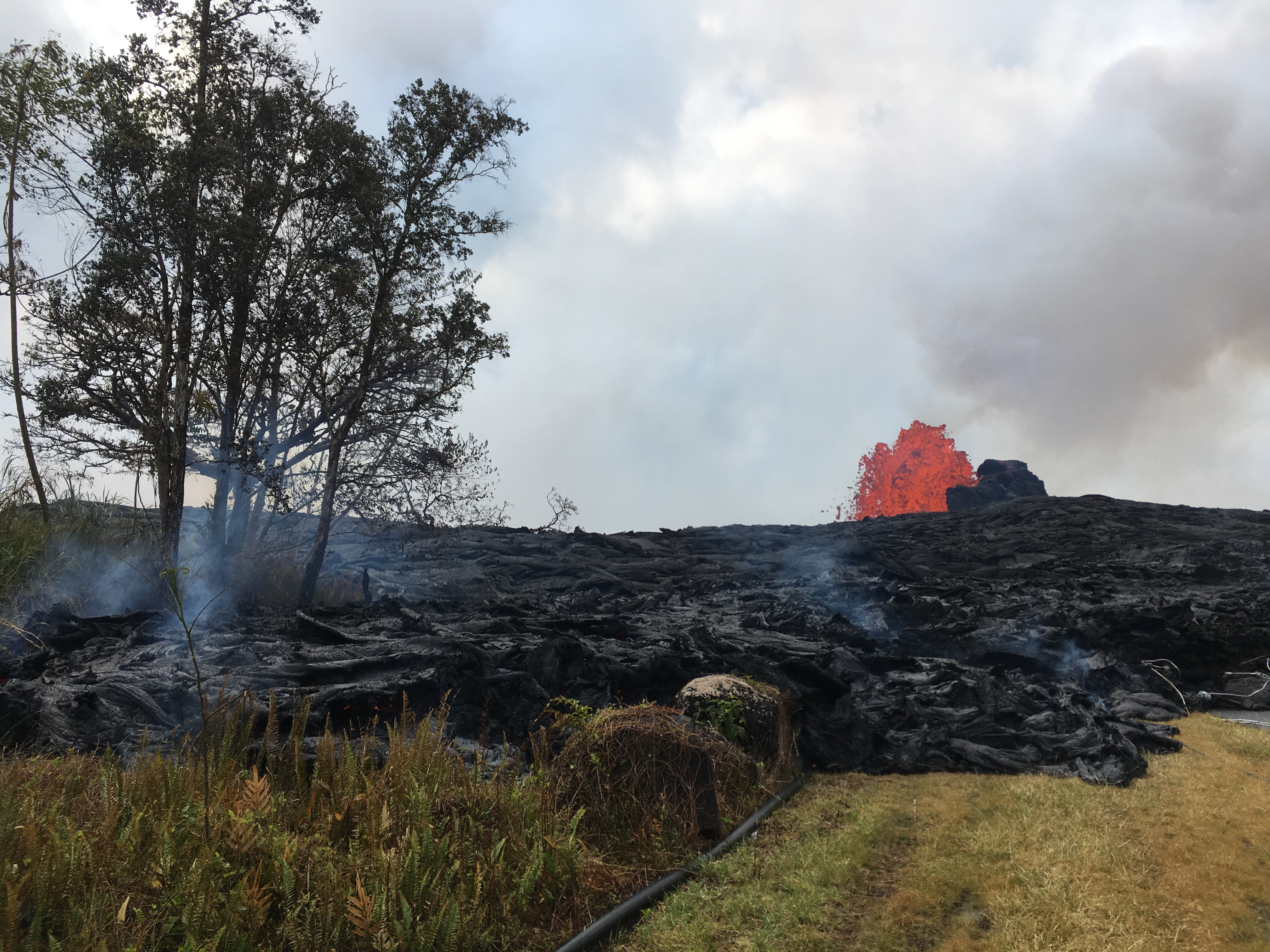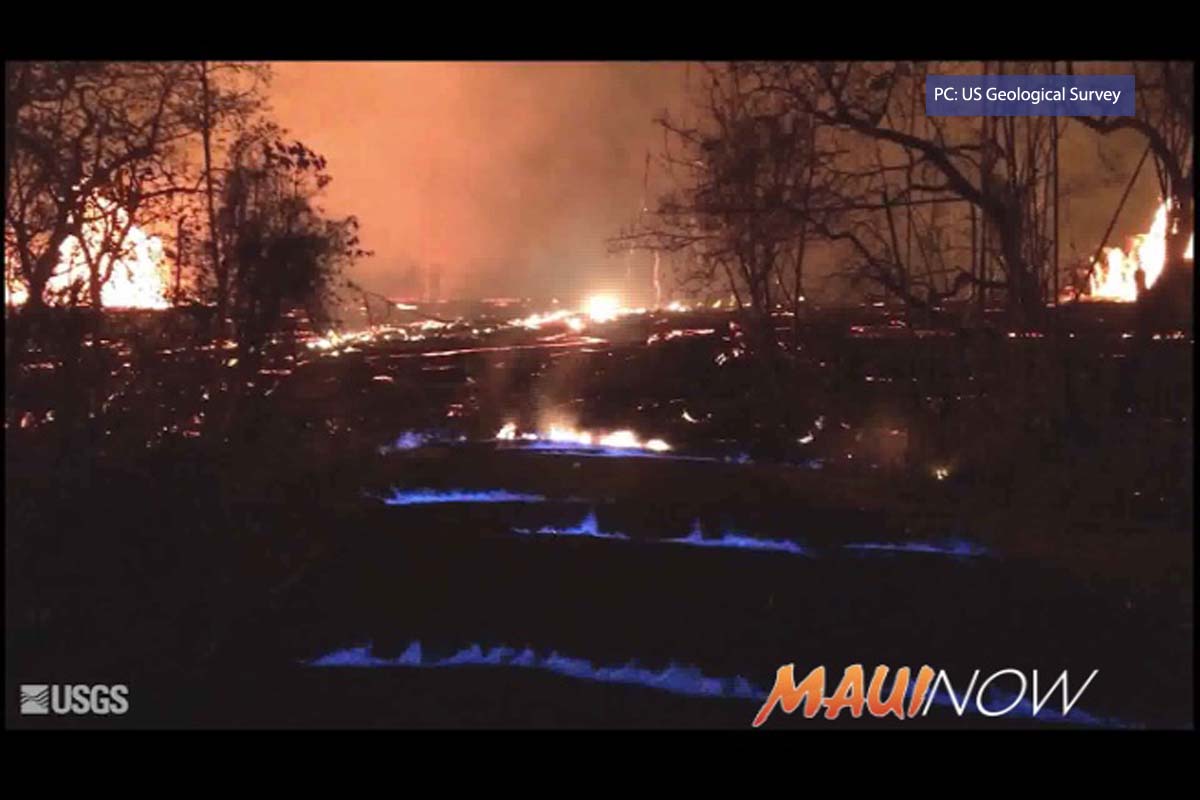Molten Lava Plus Vegetation Create “Methane Explosions”

When molten lava encroaches on grassland, forests, or other vegetated land, subsurface pockets of natural gas from the burning plant material can ignite, causing a blast known as a “methane explosion.” To avoid this hazard, keep a safe distance—at least tens of yards—from the margin of an active lava flow in vegetated areas. PC: USGS
Numerous hazards are associated with active lava flows, and USGS Hawaiian Volcano Observatory scientists have written about many of them in the past; However, it’s been a while since one particular hazard—so-called “methane explosions”—has been addressed.
With lava now advancing through lush vegetation along Kīlauea Volcano’s lower East Rift Zone, these explosions have become a concern.
Here’s the fact: If you approach a lava flow that’s encroaching on vegetation, you risk being greeted by the blast of an explosion.
Depending on how close you are to the advancing flow, your experience could range from hearing a far-away “boom,” to being thrown several meters (yards) across hard, abrasive lava as the ground beneath you disintegrates. Regardless of where you’re standing, the sound of these explosions is a call for your respect.
As a lava flow enters grassland or forest, all the biomass in the flow’s path becomes available for one or both of two processes: combustion and/or pyrolysis. Let us explain:
Lava erupted at Kīlauea is around 1150 degrees Celsius (2100 degrees Fahrenheit)—about four times hotter than your kitchen oven’s maximum temperature. Most natural materials on the ground surface, such as grasses and shrubs, are immediately burned up (combusted) as lava covers the area. But the bases of large trees are often encased in lava, charring the outside trunk, but not completely burning the inside.
When lava advances across the ground, surface vegetation either burns or is buried before it can combust. Intense heat from the lava flow also radiates downward and slowly “cooks” the buried vegetation or subsurface plant matter (for example, roots).
The lava temperature is high enough to accelerate chemical breakdown of biomass as it heats or distills the organic compounds (natural gas) from the buried grass, shrubs, ferns, roots, and other vegetation.
A similar process—pyrolysis—cooks wood in large, very hot ovens to make charcoal and another fuel byproduct called “producer gas.” Commercially, the flammable producer gas is extracted and burned to generate heat or electricity.
On Kīlauea, both producer gas and the gas generated by the lava flow consist of a mixture that includes methane, hydrogen, and carbon monoxide.
Beneath molten lava, the gas mixture from “cooked” biomass invades subsurface passages, such as old lava tubes, and below ground cracks and voids. This natural gas, of which methane is just one component, combines with air in these empty spaces to form combustible gas pockets. Recall from high school science that with the right proportions of fuel (such as methane), oxygen (such as air), and heat (such as a match), you can make fire.
When the underground air-fuel mixture is between 5 and 15 volume-percent fuel, a spark—or heat from a lava flow—can ignite it. If ignition occurs in a constricted space, such as an underground void or old lava tube, an explosion might occur.
This is similar to what happens in your car’s engine. As the air-fuel mixture is ignited in the confined space of the engine’s cylinders, the energy released ultimately propels you down the road. Likewise, if you’re standing above a subsurface void when it explodes, you might also be propelled—upward—by the blast.
Natural gas explosions (often called “methane explosions”) can occur beneath an advancing lava flow, thereby throwing molten rock into the air, or beneath old lava, throwing boulders, up to a yard (several feet) in diameter, skyward. The combustible gas mixture can seep into void spaces tens of meters (yards) from the margin of a lava flow, so it’s important to stay well away from active lava that’s moving through vegetation—especially lush vegetation like that on Kīlauea’s lower East Rift Zone.

A blue burning flame of methane gas was observed in the cracks on Kahukai Street during the overnight hours. When lava buries plants and shrubs, methane gas is produced as a byproduct of burning vegetation. Methane gas can seep into subsurface voids and explode when heated, or as shown in this video, emerge from cracks in the ground several feet away from the lava. When ignited, the methane produces a blue flame. PC: US Geological Survey
Subsurface natural gas can also seep passively to the surface. With heat from molten lava, methane can burn with blue flames—like those recently observed on and near the current lava flows.
Countless “methane explosions” have occurred during the past 35-plus years of Kīlauea’s ongoing eruption—and some have resulted in injuries to unwary spectators standing too close to hot lava on vegetated land. But it’s easy to avoid this hazard. Keep a safe distance—and respect any “booms” you hear. They’re trying to tell you something.
Volcano Activity Updates
On KīlaueaVolcano’s East Rift Zone, low-level eruption of lava continues from multiple points along the active fissure system. Residents in the lower Puna District of Hawaiʻi Island should remain informed and heed Hawaiʻi County Civil Defense closures, warnings, and messages.
At Kῑlauea’s summit, multiple explosions continue to occur daily, with some sending plumes of ash up to 8,000 feet above sea level or higher. With prevailing trade winds this past week, the ash clouds were largely blown to the southwest, resulting in trace amounts of ash falling on downwind areas. Summit activity could again become more explosive, increasing the intensity of ash production and producing ballistic projectiles close to the vent. Communities downwind should be prepared for ashfall as long as this activity continues.
Mauna Loa is not erupting. Rates of deformation and seismicity have not changed significantly over the past week. The number of monthly and weekly earthquakes recorded beneath the volcano has decreased to near background levels.
Eleven earthquakes were reported felt in Hawaiʻi during the past week. Many were related to continued deflation at Kīlauea’s summit and with the ongoing intrusion of magma into the volcano’s East Rift Zone. The largest was a magnitude-5 earthquake on May 16, at 6:15 p.m. HST, located 5 km (3 miles) southwest of Volcano and at a shallow depth.
*Volcano Watch is a weekly article and activity update written by US Geological Survey Hawaiian Volcano Observatory scientists and affiliates.










